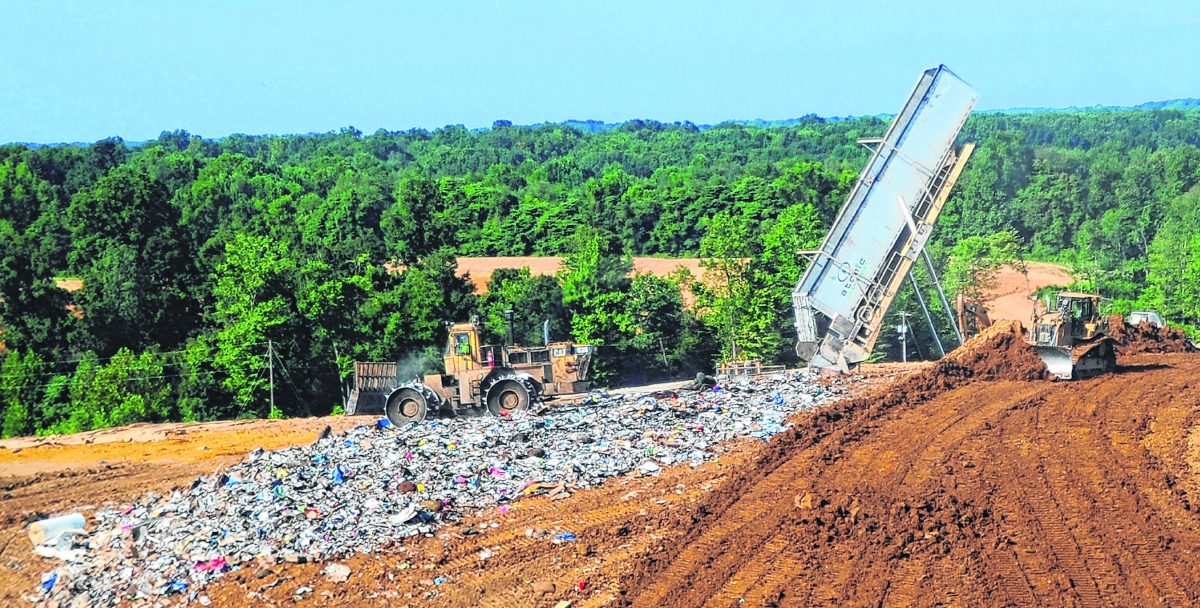
MEDORA
While the odor from the landfill isn’t pleasant for most visitors, the people working at Rumpke Waste and Recycling have no problem with it.
“That’s the smell of money,” said Brad Marlow, manager of the Medora Landfill.
[sc:text-divider text-divider-title=”Story continues below gallery” ]Click here to purchase photos from this gallery
The Greater Seymour Chamber of Commerce agribusiness committee arranged a tour of Rumpke’s facility Friday. The tour took a school bus around the landfill, showing what happens to trash and recyclables after they leave homes and commercial businesses.
Rumpke owns 1,600 acres with 171 currently permitted for landfilling. Of those 171, about 71 acres are currently in use.
“The message I like to drive home to people is that Jackson County has disposable capacity for a lot of years going forward,” Marlow said. “The rough number is in the 35-year range at present intake without us doing anything else.”
On a daily basis, Rumpke typically brings in 1,500 tons of waste.
Since 2008, all of the trash at Rumpke comes from within a 75-mile air radius with 5% allowed to come in from outside the area. Marlow said Rumpke seldomly takes trash from outside its radius.
“We take in about 90 commercial waste vehicles per day,” he said. “We take in right around 10 citizen-customer pickup trucks, and we get 11 commercial recycling trucks. It does vary. Sometimes, we get special one-time jobs, like if a building is being demoed.”
While a lot of the trash travels to Kentucky, almost all of the waste comes from southern Indiana. The waste is brought to a transfer station in Louisville before getting transported to Medora in large semis.
Marlow explained how hazardous waste is vetted at the scales and had the bus stop at a 13-acre cell in use that showed how construction vehicles create the landfill after a trailer brings in the waste.
“It has a synthetic layer on the bottom,” he said. “We compact 3 feet of clay, put a synthetic liner under that, put garbage on and then another synthetic liner over the top and almost seal it up like a Tupperware container and then put dirt on top of that for grass to grow.”
Landfill gas, roughly 50% methane and 50% carbon dioxide with a small amount of non-methane organic compounds, is emitted from the operation
According to the U.S. Environmental Protection Agency, landfills are the third-largest source of human-related methane emissions in the country, accounting for 14.1% in 2017.
Rumpke plans to turn that gas into energy in the near future.
“We already have gas wells,” Marlow said. “When we place waste, it starts to break down and produce methane gas, and we have gas wells hooked into that. In May, Rumpke signed an agreement with a company to recover that gas. A lot of landfills will create electricity with it.
“While we haven’t had our final planning meetings, we have an agreement,” he said. “Our gas will be clean and put into the main pipelines. It will be a beneficial reuse, whether it be electricity or into the pipeline.”
Right now, Rumpke vents most of the landfill gas. Some of the gas is burned, and Marlow said Rumpke hopes to have progress on the system next year.
Richard Rieckers of Seymour said he was impressed by the scale of the business.
“It was kind of interesting to find out just how big it was and how deep it goes,” Rieckers said. “I’m retired, and a buddy invited me to come today. I had always heard that they brought all of their trash there from Louisville, and it turned out it’s not Louisville trash but from southern Indiana. I’ve always thought Rumpke does a pretty good job.”
Toward the end of the tour, the bus went by the recycling center, which opened in 2017.
Debbie Hackman, director of the Jackson County Recycling District, said the recycling district and Rumpke have a strong relationship.
“In 1990, the state legislature said that every county needed to have a solid waste district and that they weren’t going to fund it,” Hackman said. “In Jackson County, the commissioners at that time decided they were going to fund it on fees by the landfill. Every ton of trash that goes into the landfill, (Rumpke) pays a dollar to the recycling district to fund our recycling programs in the county. Otherwise, we would be paying it out of our tax dollars, which most counties do.”
The Medora Recycling Center takes residential and commercial recyclables, such as paper, glass and plastic bottles, metal cans and cartons.
The center features a 5,540-square-foot concrete pad, which is used for single-stream recyclables and source-separated corrugated contagions.
There is a conveyor line that feeds the recyclables to a manual sorting station, where contaminated items are removed.
Hillary Ladig, Rumpke’s corporate communications coordinator, said 98% of the material recycled in Medora stays in the country.
Marlow said Rumpke has 80 employees in Medora, and the company battles the elements as it opens every day but Sundays, Christmas Day and New Year’s Day.
Kathy Cameron of Louisville said the tour offered a good look at the business.
“I thought it was a great tour,” she said. “I have done environmental work for a long time, and it’s good to know that we have a local resource for recycling. I think everyone should know where their waste goes. It’s an impressive operation over there.”
Once the landfill reaches capacity, Rumpke will be responsible for its maintenance for the next 30 years, Marlow said.
